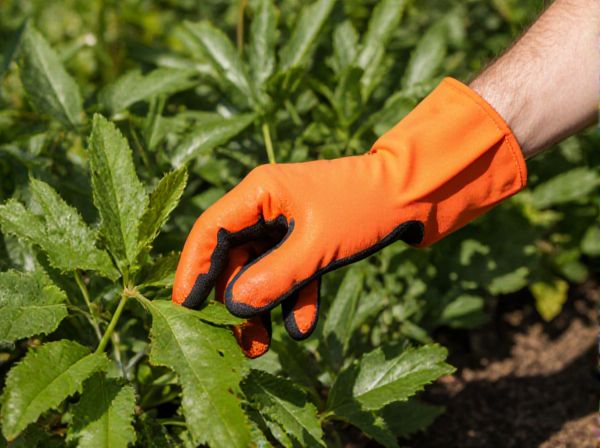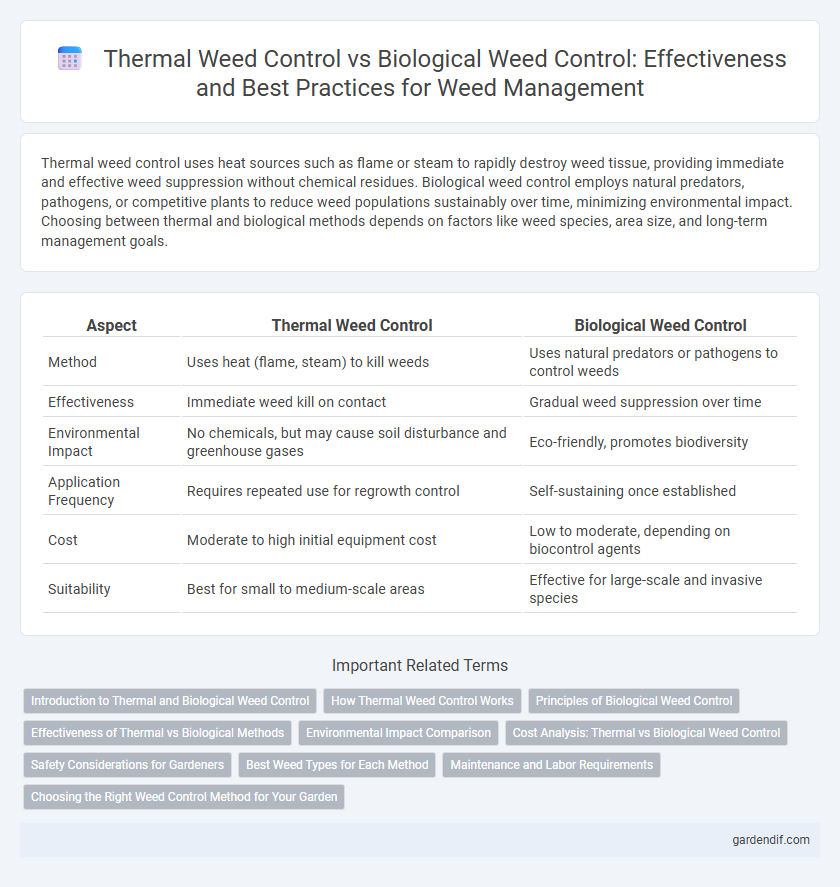
Thermal weed control vs Biological weed control Illustration
Thermal weed control uses heat sources such as flame or steam to rapidly destroy weed tissue, providing immediate and effective weed suppression without chemical residues. Biological weed control employs natural predators, pathogens, or competitive plants to reduce weed populations sustainably over time, minimizing environmental impact. Choosing between thermal and biological methods depends on factors like weed species, area size, and long-term management goals.
Table of Comparison
| Aspect | Thermal Weed Control | Biological Weed Control |
|---|---|---|
| Method | Uses heat (flame, steam) to kill weeds | Uses natural predators or pathogens to control weeds |
| Effectiveness | Immediate weed kill on contact | Gradual weed suppression over time |
| Environmental Impact | No chemicals, but may cause soil disturbance and greenhouse gases | Eco-friendly, promotes biodiversity |
| Application Frequency | Requires repeated use for regrowth control | Self-sustaining once established |
| Cost | Moderate to high initial equipment cost | Low to moderate, depending on biocontrol agents |
| Suitability | Best for small to medium-scale areas | Effective for large-scale and invasive species |
Introduction to Thermal and Biological Weed Control
Thermal weed control uses heat-based methods such as flame weeding and hot water to destroy weed tissues, offering quick and chemical-free solutions for weed management. Biological weed control relies on natural organisms like insects, fungi, or bacteria to suppress weed populations, providing sustainable and environmentally friendly alternatives. Both approaches reduce reliance on synthetic herbicides and support integrated weed management strategies.
How Thermal Weed Control Works
Thermal weed control eliminates weeds by applying intense heat that destroys cell structure and disrupts metabolic functions, causing rapid plant tissue damage. Methods include flame weeding, hot water spraying, and steam treatment to target seedlings and shallow-rooted weeds without chemicals. This approach offers an eco-friendly alternative with immediate results, effectively reducing weed growth in agricultural and urban environments.
Principles of Biological Weed Control
Biological weed control relies on using natural predators, pathogens, or competitive plants to suppress weed populations by disrupting their life cycles and reducing their vigor. This method focuses on ecological balance, where introduced agents specifically target invasive or problematic weeds without harming crops or native species. Unlike thermal weed control, which eliminates weeds through heat application, biological control provides sustainable, long-term weed management by enhancing natural ecosystem resistance.
Effectiveness of Thermal vs Biological Methods
Thermal weed control effectively targets unwanted plants by using high temperatures to destroy cellular structure, providing rapid results especially useful in large-scale or industrial applications. Biological weed control employs natural predators, pathogens, or competitive plants, offering sustainable management with minimal environmental impact but slower and more variable effectiveness. Studies indicate thermal methods deliver immediate reduction in weed populations, whereas biological control requires time to establish and may be more effective for long-term ecosystem restoration.
Environmental Impact Comparison
Thermal weed control uses heat to eliminate weeds, reducing chemical herbicide reliance but consuming significant energy and potentially harming soil microorganisms. Biological weed control introduces natural predators or pathogens, promoting long-term ecosystem balance and minimizing soil and water contamination risks. Both methods offer environmentally friendly alternatives, yet biological control tends to have a lower carbon footprint and supports biodiversity more effectively than thermal treatment.
Cost Analysis: Thermal vs Biological Weed Control
Thermal weed control often involves higher upfront equipment costs but offers rapid results and reduced labor expenses over time, making it cost-effective for large-scale operations. In contrast, biological weed control requires lower initial investment but may incur ongoing costs related to agent monitoring and slower efficacy, potentially extending management timelines. Evaluating total cost over multiple seasons reveals that thermal methods can provide quicker return on investment, while biological control is economically advantageous for sustainable, long-term weed suppression.
Safety Considerations for Gardeners
Thermal weed control uses heat to eliminate weeds, reducing chemical exposure risks but requiring careful handling to avoid burns or fire hazards. Biological weed control relies on natural predators or pathogens, minimizing physical danger but necessitating awareness of ecological impacts and potential allergenic reactions. Gardeners should evaluate safety protocols specific to each method to ensure effective and hazard-free weed management.
Best Weed Types for Each Method
Thermal weed control is most effective for annual weeds such as crabgrass and chickweed, as the high heat rapidly destroys their delicate cell structures. Biological weed control targets perennial weeds like bindweed and thistle through natural predators or pathogens that inhibit their growth over time. Selecting the ideal method depends on the weed species' life cycle and resilience to heat or biological agents.
Maintenance and Labor Requirements
Thermal weed control demands regular equipment operation and energy inputs, making it labor-intensive but offering immediate effect on weed populations. Biological weed control requires ongoing monitoring and management of natural predators or pathogens, which involves less physical labor but continuous ecological oversight. Maintenance for thermal methods centers on machinery upkeep, while biological control focuses on sustaining healthy ecosystems to ensure the effectiveness of control agents.
Choosing the Right Weed Control Method for Your Garden
Thermal weed control uses high temperatures to destroy weed tissue quickly, ideal for immediate results in small to medium garden areas. Biological weed control relies on natural predators or pathogens to suppress weed growth, offering a sustainable and eco-friendly approach suited for long-term management. Selecting between these methods depends on garden size, weed species, environmental impact, and desired speed of results.
Thermal weed control vs Biological weed control Infographic

 gardendif.com
gardendif.com